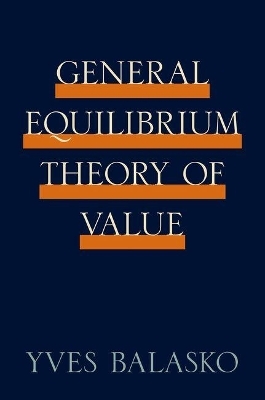
General Equilibrium Theory of Value
Princeton University Press (Verlag)
978-0-691-14679-9 (ISBN)
- Titel z.Zt. nicht lieferbar
- Versandkostenfrei
- Auch auf Rechnung
- Artikel merken
The concept of general equilibrium, one of the central components of economic theory, explains the behavior of supply, demand, and prices by showing that supply and demand exist in balance through pricing mechanisms. The mathematical tools and properties for this theory have developed over time to accommodate and incorporate developments in economic theory, from multiple markets and economic agents to theories of production. Yves Balasko offers an extensive, up-to-date look at the standard theory of general equilibrium, to which he has been a major contributor. This book explains how the equilibrium manifold approach can be usefully applied to the general equilibrium model, from basic consumer theory and exchange economies to models with private ownership of production. Balasko examines properties of the standard general equilibrium model that are beyond traditional existence and optimality. He applies the theory of smooth manifolds and mappings to the multiplicity of equilibrium solutions and related discontinuities of market prices.
The economic concepts and differential topology methods presented in this book are accessible, clear, and relevant, and no prior knowledge of economic theory is necessary. General Equilibrium Theory of Value offers a comprehensive foundation for the most current models of economic theory and is ideally suited for graduate economics students, advanced undergraduates in mathematics, and researchers in the field.
Yves Balasko is professor of economics at the University of York. He is the author of "Foundations of the Theory of General Equilibrium and The Equilibrium Manifold".
Preface xi CHAPTER 1: Goods and Prices 1 1.1 Introduction 1 1.2 Goods 1 1.3 Prices 2 1.4 Relative Prices 2 1.5 Price Normalization 3 1.6 Notes and Comments 4 CHAPTER 2: Preferences and Utility 5 2.1 Consumption Sets 5 2.2 Binary Relations 6 2.3 Consumers' Preferences 8 2.4 Smooth Utility Functions 14 2.5 Conclusion 18 2.6 Notes and Comments 18 CHAPTER 3: Demand Functions 19 3.1 Introduction 19 3.2 Constrained Utility Maximization 19 3.3 The Individual Demand Function 23 3.4 Properties of Demand Functions in D 24 3.5 Demand-based Consumer Theory 31 3.6 Conclusion 36 3.7 Notes and Comments 36 CHAPTER 4: The Exchange Model 37 4.1 Introduction 37 4.2 The Sets E, Er, and Ec of m-tuples of Demand Functions Defining the Exchange Model 38 4.3 The Exchange Model 39 4.4 Equilibrium Equation 39 4.5 The Equilibrium Manifold and the Natural Projection 41 4.6 The Smooth Equilibrium Manifold 42 4.7 Smoothness of the Natural Projection 44 4.8 Critical and Regular Points and Values 44 4.9 Notes and Comments 46 CHAPTER 5: The Equilibrium Manifold 47 5.1 Introduction 47 5.2 Global Properties and Their Interest 47 5.3 The No-trade Equilibria 49 5.4 The Fibers of the Equilibrium Manifold 50 5.5 The Equilibrium Manifold as a Collection of Linear Fibers Parameterized by the No-trade Equilibria 52 5.6 A Picture of the Equilibrium Manifold 53 5.7 Diffeomorphism with R_m 53 5.8 Conclusion 54 5.9 Notes and Comments 55 CHAPTER 6: Applications of the Global Coordinate System 56 6.1 Introduction 56 6.2 Coordinate System (A) 56 6.3 Coordinate System (B) 57 6.4 Formulas of the Natural Projection 57 6.5 The Jacobian Matrix of Aggregate Excess Demand 58 6.6 Conclusion 61 6.7 Notes and Comments 61 CHAPTER 7: The Broad Picture 62 7.1 Introduction 62 7.2 Properness 62 7.3 Smooth Selection at a Regular Equilibrium 63 7.4 The Equilibrium Manifold over Regular Economies 64 7.5 Genericity of Regular Economies 67 7.6 The Degrees of the Natural Projection 69 7.7 Conclusion 72 7.8 Notes and Comments 73 CHAPTER 8: The Fine Picture 74 8.1 Introduction 74 8.2 Aggregate Demand at a No-trade Equilibrium 74 8.3 Regularity of the No-trade Equilibria 75 8.4 The Set of Equilibrium Allocations 75 8.5 Economies with a Unique Equilibrium 78 8.6 Degree of the Natural Projection 79 8.7 The Set of Regular Equilibria 79 8.8 Conclusion 81 8.9 Notes and Comments 81 CHAPTER 9: Production with Decreasing Returns 82 9.1 Introduction 82 9.2 Production Sets: Definitions 82 9.3 Production Sets: Main Properties 84 9.4 The Firm's Objective Function 89 9.5 The Strict Decreasing Returns to Scale Firm 90 9.6 The Net Supply Function as a Primitive Concept 92 9.7 Conclusion 94 9.8 Notes and Comments 95 CHAPTER 10: Equilibrium with Decreasing Returns 96 10.1 Introduction 96 10.2 The General Equilibrium Model with Private Ownership of Decreasing Returns to Scale Firms 96 10.3 Production Adjusted Demand Functions 98 10.4 The Equivalent Exchange Model 101 10.5 Properness of the Natural Projection 103 10.6 Conclusion 107 10.7 Notes and Comments 107 CHAPTER 11: Production with Constant Returns 108 11.1 Introduction 108 11.2 Production Sets 109 11.3 The Net Supply Correspondence 112 11.4 Three Examples 115 11.5 Net Supply Correspondence of a Smooth Constant Returns to Scale Firm 118 11.6 The Graph of the Net Supply Correspondence 120 11.7 Conclusion 123 11.8 Notes and Comments 123 CHAPTER 12: Equilibrium with Constant Returns 124 12.1 Introduction 124 12.2 Decreasing and Constant Returns: General Case 124 12.3 Constant Returns: Reduced Form 125 12.4 Equilibria of the Model N 126 12.5 The Equilibrium Manifold Approach 126 12.6 The Equilibrium Manifold for the Model N 127 12.7 The Natural Projection 133 12.8 Regular and Critical Equilibria 134 12.9 Degrees of the Natural Projection 137 12.10 Regular and Singular Economies 138 12.11 Uniqueness of Equilibrium over ?(T) 139 12.12 The Natural Projection as a Finite Covering of the Set of Regular Economies 141 12.13 Values of the Natural Projection Degrees 143 12.14 Conclusion 144 12.15 Notes and Comments 144 Postscript 145 APPENDIX A: Notation 149 A.1 Points, Vectors, Inner Product 149 A.2 Gradient 149 A.3 Second-Order Derivatives and the Hessian Matrix of a Smooth Function 150 APPENDIX B: Point-set Topology 151 B.1 Proper Maps 151 APPENDIX C: Smooth Manifolds 152 C.1 The Implicit Function Theorem 152 C.2 Smooth Manifolds and Submanifolds 152 C.3 Smooth Mappings, Immersions, and Submersions 153 APPENDIX D: Singularities of Smooth Maps 155 D.1 Critical and Regular Points 155 D.2 Singular and Regular Values 155 D.3 Sard's Theorem 156 D.4 The Regular Value Theorem 156 D.5 The Case where dimX = dimY 156 D.6 Coverings 157 D.7 Surjectivity of Maps with Non-Zero Modulo 2 Degree 157 APPENDIX E: Convexity 159 E.1 Convex and Strictly Convex Sets 159 E.2 Quasi-concave Functions 159 E.3 Smooth Quasi-concavity and Second-Order Derivatives 162 E.4 Bordered Hessian of a Smoothly Quasi-concave Function 164 E.5 Recession Cone of a Convex Set 165 APPENDIX F: Miscellany 166 F.1 Dimension of Semi-algebraic Sets 166 References 167 Index 171
| Erscheint lt. Verlag | 14.8.2011 |
|---|---|
| Zusatzinfo | 8 line illus. |
| Verlagsort | New Jersey |
| Sprache | englisch |
| Maße | 152 x 235 mm |
| Gewicht | 567 g |
| Themenwelt | Wirtschaft ► Allgemeines / Lexika |
| Wirtschaft ► Volkswirtschaftslehre ► Mikroökonomie | |
| Wirtschaft ► Volkswirtschaftslehre ► Ökonometrie | |
| ISBN-10 | 0-691-14679-9 / 0691146799 |
| ISBN-13 | 978-0-691-14679-9 / 9780691146799 |
| Zustand | Neuware |
| Haben Sie eine Frage zum Produkt? |
aus dem Bereich


